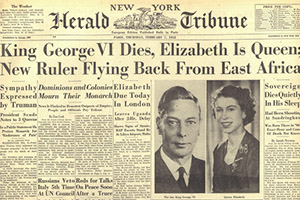
History-Periods
Past eras

From pre-history to today
Choose your period

Periods of History
explore the different eras

George VI was born on December 14, 1895, at York Cottage, Sandringham, Norfolk, England. He was the second son of King George V and Queen Mary and had an elder brother, Edward VIII, who was the heir to the throne.
George VI was not expected to become king, as his elder brother was the heir apparent. As a result, he was not given the same level of education and training for his future role as king. Instead, he pursued a career in the Royal Navy and served during World War I.
In 1920, George VI met Elizabeth Bowes-Lyon, who was known as "Lilibet" to her family and friends. They fell in love and were married in 1923. The couple had two daughters, Elizabeth (born in 1926) and Margaret (born in 1930).
In 1936, George VI's life was turned upside down when his elder brother, Edward VIII, abdicated the throne to marry the American socialite, Wallis Simpson. As a result, George VI became king, despite his lack of preparation for the role and his struggle with a severe stammer.
Despite his initial reluctance to take on the role of king, George VI worked hard to overcome his speech impediment and went on to become a much-loved and respected monarch. He supported Britain through World War II, providing a source of inspiration and hope to the nation during the difficult times of the Blitz.
In addition to his leadership during World War II, George VI also played a key role in the formation of the Commonwealth, which is a group of countries that were once part of the British Empire. He believed that the Commonwealth could help promote peace and cooperation between nations, and he worked hard to foster closer ties between the member countries.
George VI's reign was also marked by significant social and political changes in Britain. He oversaw the creation of the National Health Service (NHS) and the welfare state, which aimed to provide support and assistance to those in need. He also presided over the decolonization of the British Empire, with many former colonies gaining their independence during his reign.
George VI's health began to decline in the late 1940s, and he was diagnosed with lung cancer in 1951. Despite his illness, he continued to carry out his duties as king, but his health deteriorated rapidly, and he died on February 6, 1952, at Sandringham House, Norfolk.
George VI was succeeded by his daughter, Elizabeth II, who has since become the longest-reigning monarch in British history. George VI's legacy is one of courage, resilience, and dedication to public service, and he is remembered as a beloved and respected monarch who helped guide Britain through some of its most challenging times.
In 1948, George VI was diagnosed with arterial stenosis, a condition that restricted blood flow to his legs and caused him to experience pain and difficulty walking. He underwent several surgical procedures to try and alleviate the condition, but his health continued to deteriorate in the years that followed.
In 1951, George VI began experiencing persistent coughing and shortness of breath. He underwent a series of medical tests, which revealed a small area of scarring on his lung tissue. Despite the discovery, George VI continued to carry out his duties as king, traveling to the Commonwealth countries and attending public engagements.
In September 1951, George VI embarked on a six-month tour of Australia and New Zealand, which was intended to strengthen the ties between Britain and the Commonwealth. However, his health continued to decline during the trip, and he began experiencing chest pains and difficulty breathing. His doctors advised him to cut the trip short and return to Britain for further medical treatment.
Upon his return to Britain, George VI underwent a biopsy, which revealed that he had lung cancer. The news was kept secret from the public, and the king continued to carry out his public duties, albeit with reduced energy and stamina.
George VI spent his final months at Sandringham House, Norfolk, where he was cared for by his wife, Elizabeth, and a team of doctors and nurses. His condition gradually worsened, and he became weaker and more frail. On the morning of February 6, 1952, he died peacefully in his sleep, surrounded by his family.
The news of George VI's death came as a shock to the British people, who had grown to love and respect the king during his reign. Tributes poured in from around the world, with many praising his courage, dedication to duty, and unwavering commitment to public service.
e death of George VI had a significant impact on the operation of the government, as it triggered a period of mourning and transition that lasted several weeks.
Immediately after George VI's death, the government entered a period of official mourning, during which time all public events and celebrations were canceled or postponed. This period of mourning also affected the operation of Parliament, with many sessions and meetings being suspended or delayed as a mark of respect.
In addition to the period of mourning, George VI's death also triggered a period of transition, as his daughter, Princess Elizabeth, ascended to the throne as Queen Elizabeth II. This transition involved a complex process of legal and ceremonial procedures, including the proclamation of the new monarch and the swearing-in of the new government.
The transition period also involved significant changes in the roles and responsibilities of key figures within the government. For example, the Prime Minister, Winston Churchill, who had served under George VI, was reappointed as Prime Minister under Queen Elizabeth II.
Despite these changes, the operation of government continued throughout the transition period, with key officials and ministers working to ensure a smooth and orderly transfer of power. In the weeks and months that followed, the government continued to function under the new monarch, with the Queen assuming her role as the head of state and performing her ceremonial and constitutional duties.
George VI was succeeded by his daughter, Elizabeth II, who was crowned queen later that year. The legacy of George VI as a beloved and respected monarch has continued to this day, with his life and reign being celebrated as an important chapter in the history of the British monarchy.
The death of George VI had a profound effect on the English people, who had grown to love and respect the king during his reign. George VI was widely regarded as a devoted and conscientious monarch, who had worked tirelessly to support his people through some of the most difficult times in British history.
News of George VI's death was met with shock and sadness across the country, with many people expressing their grief through public mourning and displays of respect. Flags were flown at half-mast, and many public events and celebrations were canceled or postponed as a mark of respect.
The funeral of George VI was held on February 15, 1952, and was attended by thousands of mourners, including members of the royal family, government officials, and representatives from across the Commonwealth. The funeral procession was broadcast live on television and radio, allowing people across the country to pay their respects to the late king.
In the weeks and months that followed George VI's death, the country continued to mourn and reflect on his life and legacy. Many people remembered him as a kind and compassionate leader, who had worked tirelessly to support his people through some of the most challenging times in British history.
Today, the legacy of George VI lives on, with his reign being remembered as an important chapter in the history of the British monarchy. His dedication to public service and commitment to his people continue to inspire future generations of leaders and public servants.
If you have a suggestion regarding additional topics you would like to see included - please let us know
Reference: Article by Greg Scott (Staff Historian), 2024
Tour Reviews
History Attractions
Submit Tour Suggestions
2024 Departures
Spotlight Tours
Events and anniversaries

All content and images are protected by copyright to Access History